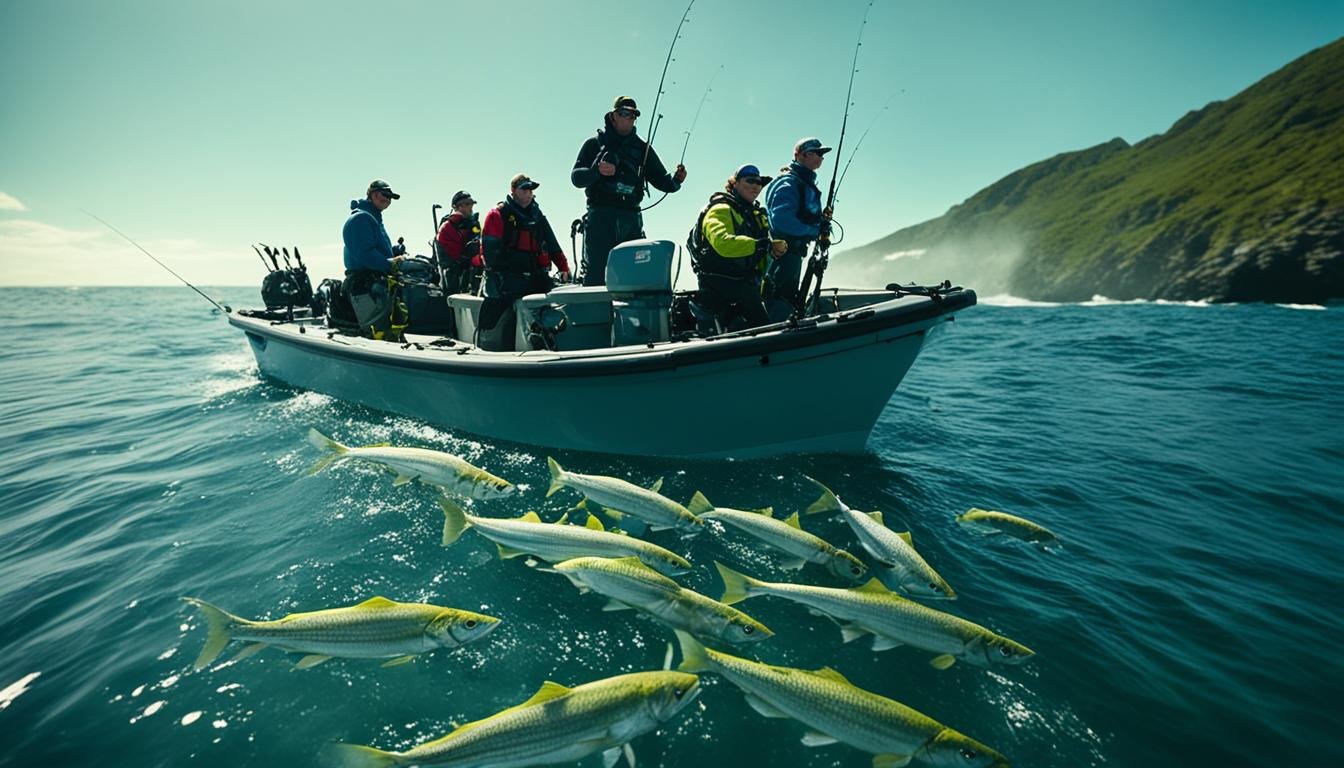Are you ready to unlock the secrets of successful bottom fishing and take your angling skills to new depths?
In this comprehensive guide, we’ll explore the essential techniques, gear, and strategies that will elevate your game and ensure an unforgettable private fishing trip.
Whether you’re a seasoned pro or a beginner eager to cast your first line, mastering bottom fishing can make all the difference between a good day on the water and an extraordinary one. From jigging and drift fishing to live bait techniques and deep drop targeting, we’ll cover the full spectrum of bottom fishing approaches to help you connect with a diverse array of species thriving in Canada’s rich marine ecosystems.
Key Takeaways about Bottom Fishing Techniques
- Discover the essential bottom fishing techniques for targeting a variety of species in Canadian waters
- Understand the importance of selecting the right gear, from rigs to knots, to maximize your success
- Learn how to identify and locate the most productive bottom fishing hotspots
- Explore advanced strategies like jigging, drift fishing, and deep drop fishing to take your angling to new depths
- Unlock the secrets of live bait fishing and chumming for a more dynamic and rewarding bottom fishing experience
Understanding Bottom Fishing Basics
Mastering the art of bottom fishing requires a deep understanding of the right gear and the underwater landscape. Anglers must carefully select the appropriate jig weights, line, and rods to effectively bounce their lures along the seafloor, targeting the prime habitats of species like Grouper and Snapper.
Choosing the Right Gear
When it comes to bottom fishing, the right gear is crucial for success. Anglers need to opt for heavy-duty rods and reels, paired with braided or monofilament fishing lines that can withstand the rigors of bouncing along the ocean floor. The selection of jig weights is equally important, as heavier weights are often necessary to maintain contact with the bottom, especially in strong currents.
Identifying Prime Bottom Structure
The key to finding productive bottom fishing spots lies in understanding the underwater terrain. Anglers should seek out rocky reefs, sunken wrecks, and other prime bottom structures where target species like Grouper and Snapper are known to congregate. By identifying these areas, anglers can increase their chances of success and enjoy more consistent and rewarding catches.
“Bottom fishing is a crucial technique for saltwater anglers as it allows them to target specific species known to reside near the ocean floor effectively.”
Successful bottom fishing requires a combination of the right gear and a deep understanding of the underwater landscape. By mastering these fundamentals, anglers can unlock the full potential of this rewarding fishing technique and enjoy consistent and impressive catches.
Mastering the Bounce: Jigging Techniques
Jigging is a highly effective bottom fishing technique, but it requires mastering the “bounce” to ensure your jig is making consistent contact with the seafloor. Anglers need to experiment with different jig weights to find the right balance between sinking quickly and avoiding snags. Detecting subtle bottom strikes and quickly setting the hook are also essential skills for successful jigging.
Finding Bottom with the Proper Jig Weight
The key to effective jigging is using the appropriate jig weight for the depth and conditions. As a general guideline, anglers fishing in shallow water of 5 feet or less should opt for a quarter-ounce or smaller jig head, while those targeting deeper depths of 30 feet or more may need to use jigs up to two ounces. Heavier weights will sink faster, allowing you to quickly reach the bottom and maintain contact. When using monofilament line, you may need to increase the jig weight compared to braided mainline, which has less stretch and sensitivity.
To determine the correct jig weight, pay attention to how long it takes for your lure to hit the bottom. A one-ounce jig in 20 feet of water should reach the seafloor in 10-12 seconds, while a half-ounce in 10 feet should take 7-8 seconds. Experiment with different sizes until you find the optimal weight that allows you to efficiently detect bottom structure and stay connected with the jig.
Detecting Bottom Strikes and Setting the Hook
Detecting subtle bottom strikes is crucial for successful jigging. Maintain a tight line and focus on the feel and movement of the jig as it drops and bounces along the seafloor. Look for any hesitation, ticks, or sudden changes in the jig’s rhythm, as these can indicate a fish has taken the bait. Set the hook immediately and aggressively to ensure a solid hook set. Regularly check your leader for signs of abrasion or wear, especially when fishing around jagged structures or shells, to avoid losing a hard-earned catch.
To maximize your jigging effectiveness, consider rigging multiple rods with different jig sizes. This allows you to quickly switch between weights to find the most productive option for the prevailing conditions. Additionally, use high-visibility line to enhance your ability to detect even the slightest of bottom strikes.
“Jigging can be challenging, but the vertical presentation is highly effective when you master the technique. Boat control is key, as is finding the right rhythm and cadence for the specific conditions.”
Experimenting with various jigging methods, such as slow drag and snap jigging, can help you determine the most effective approach for the day. Remember, the fish will often dictate the best jig color, so be prepared to adjust your presentation accordingly. By mastering the bounce and fine-tuning your jigging skills, you’ll be well on your way to consistently catching bottom-dwelling species.
Bottom Fishing Techniques
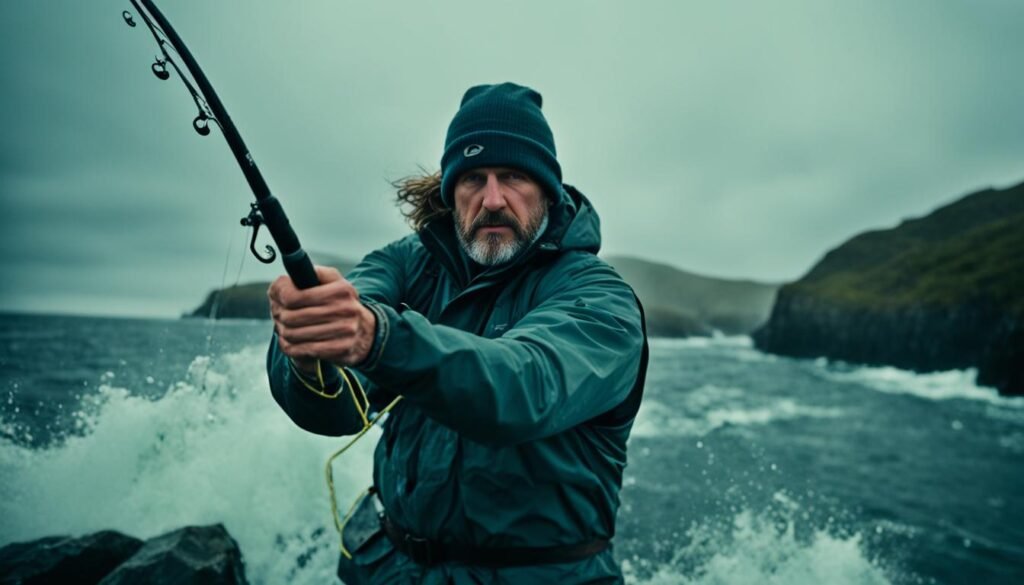
Beyond the popular jigging technique, anglers have a vast arsenal of bottom fishing techniques to target a diverse range of species. From drift fishing to anchoring and vertical jigging, each method offers unique advantages depending on the target species and fishing conditions.
Drift Fishing for Bottom Dwellers
Drift fishing allows anglers to cover more ground and present baits to a variety of bottom fishing species. By allowing the boat to drift with the current, fishermen can effectively sample different areas and depths, exposing their rigs to a wider range of potential targets. This technique is particularly useful for targeting species like flounder, which can be found in various bottom structures.
To drift fish effectively, anglers should focus on areas with prominent bottom features, such as ledges, drop-offs, and underwater structure. By maintaining a controlled drift and adjusting the amount of line paid out, anglers can ensure their baits remain in the strike zone for bottom dwellers.
Anchoring and Vertical Jigging
In contrast, anchoring and vertical jigging techniques are well-suited for targeting specific bottom-dwelling species. By securing the boat in a prime location and presenting baits or lures directly on the bottom, anglers can effectively tempt species like cod, snapper, and grouper to strike.
Vertical jigging involves actively working a weighted jig up and down the water column, allowing it to bounce along the bottom. This technique is highly effective for species that ambush prey from rocky outcrops or other underwater structures.
To master the art of vertical jigging, anglers must pay close attention to the feel and rhythm of the jig, detecting subtle bottom bumps and strikes. Setting the hook quickly and firmly is crucial when vertical jigging, as many bottom fish have bony mouths that can be challenging to penetrate.
By understanding the strengths and applications of these various bottom fishing techniques, anglers can tailor their approach to the target species and conditions, maximizing their chances of success on the water.
Live Bait Fishing on the Bottom
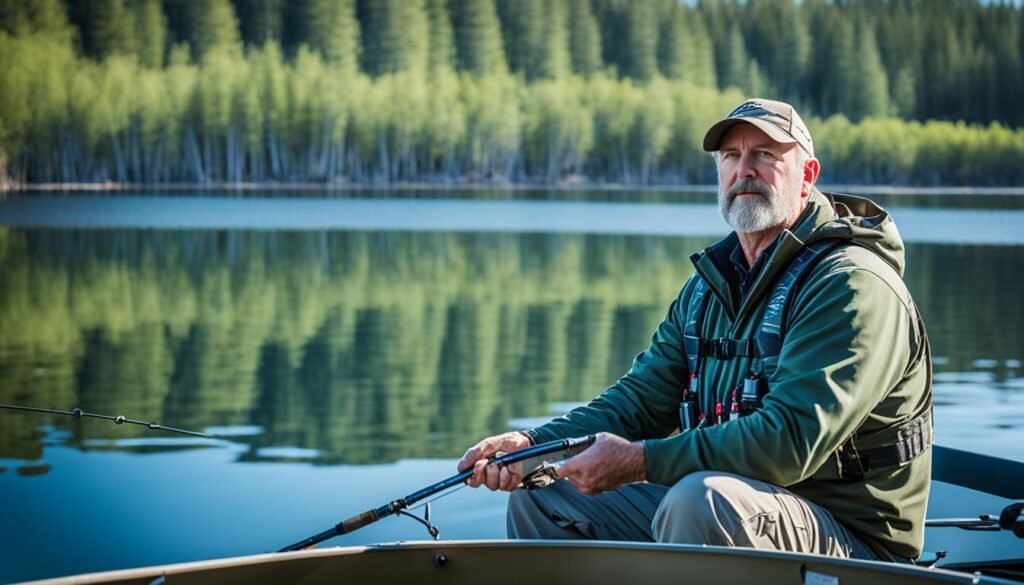
Live bait fishing is a dynamic and thrilling technique that can take bottom fishing to new heights. By understanding the behavior of both the baitfish and the predators they attract, anglers can maximize the effectiveness of live bait presentations and target a wide range of bottom-dwelling species.
One of the key advantages of live bait fishing is that it mimics the natural feeding patterns of the target fish. Live baitfish, such as shrimp, minnows, or small fish, can be rigged in a way that entices the predators lurking near the bottom. This natural presentation can be highly effective in triggering strikes from species like flounder, sea bass, snapper, and grouper.
When live bait fishing on the bottom, it’s essential to select the right gear and rig setup. A strong leader, heavy weight, and stout hook are necessary to handle the weight of the bait and the power of the fish. Variations in the weight configuration can transform the live bait into a jig-like presentation, allowing anglers to target suspended fish as well.
Properly hooking the baitfish is also crucial for an effective presentation. For shrimp, the hook should be pushed sideways through the head between the eyes and the brain, while for small fish, the hook should be pushed through the lower jaw up between the nose and eyes.
Whether you’re targeting bottom dwellers in the shallow inshore waters or venturing into the depths for deep-water species, live bait fishing can be a game-changer. By mastering the techniques and understanding the behaviors of both the bait and the predators, anglers can unlock a world of opportunities and enjoy the thrill of live bait fishing on the bottom.
| Live Bait Fishing Techniques | Key Considerations |
|---|---|
| Shallow Water Live Bait Presentations |
|
| Deep Water Live Bait Rigging |
|
| Baitfish Hooking Techniques |
|
“Live bait is considered the oldest and most reliable type of bait.”
The use of live bait for bottom fishing has recently been rekindled, suggesting a growing interest in this fishing technique among anglers. With the right approach and understanding of the bait-predator dynamics, live bait fishing can be a highly effective and exciting way to target a variety of bottom-dwelling species.
Chunking and Bottom Bouncing
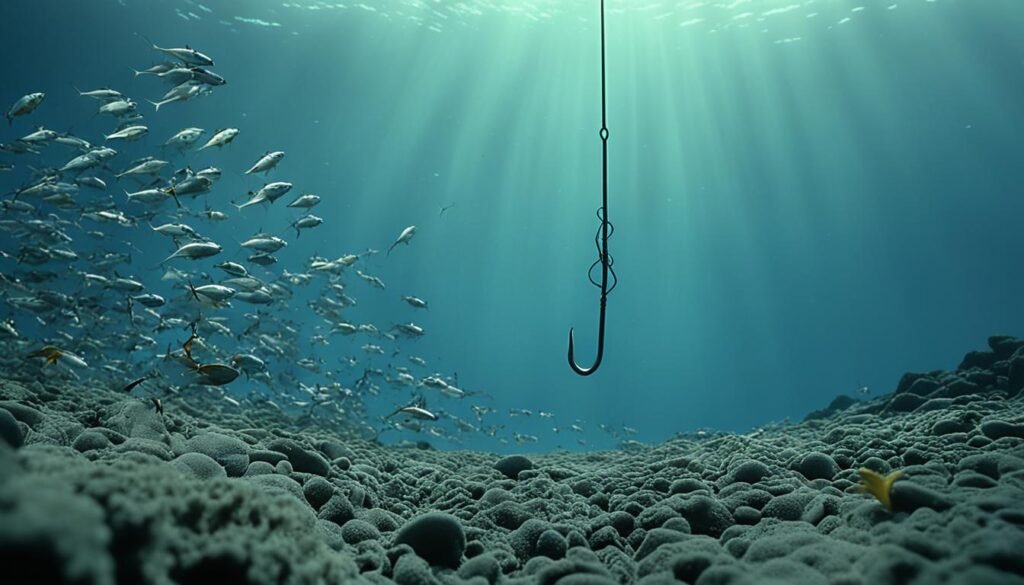
In the world of bottom fishing, two techniques stand out as highly productive – chunking and bottom bouncing. Chunking, the process of chumming the water with ground-up bait, can be a highly effective way to attract and hold bottom-dwelling fish in a particular area. Anglers can then employ a “bottom bounce” retrieve, carefully working their baits and lures along the seafloor to entice strikes.
Preparing Effective Chum Blocks
The key to successful chunking lies in the preparation of the chum blocks. Anglers can create these blocks by collecting, grinding, and freezing bait in advance of their fishing trips. The use of Kosher salt can help toughen and preserve the baits, ensuring better hook retention.
Proper placement of the chum pot on the bow of the boat is also crucial, as it helps to attract fish towards the baited hooks. The Minn Kota Ulterra with spot lock can be an invaluable tool in maintaining the boat’s position and aiding in returning to productive fishing spots.
Mastering the Bottom Bounce Retrieve
Mastering the bottom bounce retrieve is an essential skill for bottom fishing success. Anglers can adjust the weight of their bouncers to suit the depth, with a recommended weight of 1 oz per 10 feet to maintain the proper depth. Speeds for successful bottom bouncing typically range between 0.75 to 2 miles per hour, though some anglers may use heavier weights and higher speeds for high-speed trolling.
The Palomar knot is a secure choice for attaching the bouncer, and backtrolling can be an efficient method for precise contour line fishing. Maintaining the bouncer at about 6-9 inches off the bottom is the ideal depth, and anglers should be prepared to reverse direction to release the bouncer if it gets stuck.
By mastering the art of chunking and bottom bouncing, anglers can unlock the secrets of the seafloor and consistently bring home a bountiful catch. These techniques, when combined with the right gear and a keen eye for the underwater landscape, can be the key to success in the world of bottom fishing.
Deep Drop Fishing: Targeting Deep-Water Species
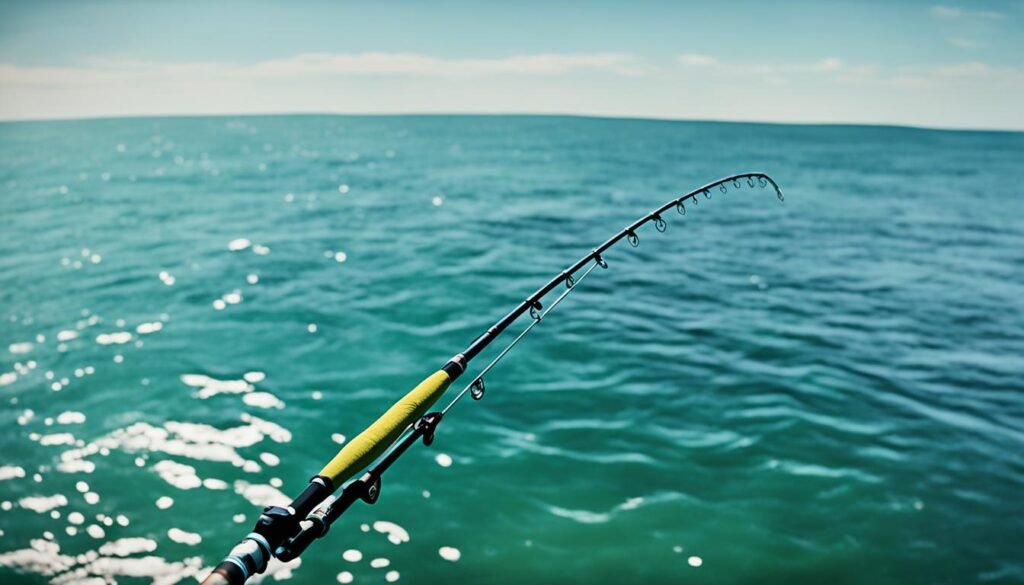
For anglers seeking to explore the depths and target elusive deep-water species, the art of deep drop fishing offers a thrilling challenge. This specialized technique requires the use of heavy-duty equipment and precise tactics to effectively reach and work lures and baits in the deeper regions of the water column.
Specialized Gear for Deep Drop Fishing
Mastering the specialized gear and equipment for deep drop fishing is essential to unlock the world of bottom-dwelling species. Anglers need to equip themselves with sturdy rods, powerful reels, and heavy-duty terminal tackle to handle the demands of this technique.
- Stout, heavy-duty rods designed for deep-water fishing are a must, capable of handling the weight of the bait and line.
- Electric reels, such as those from Kristal, Shimano, and Daiwa, have become popular choices for deep drop fishing, allowing anglers to effectively work their baits at extreme depths.
- Braided fishing lines in the 80-pound class, like Platypus, provide the necessary strength and sensitivity to detect subtle bites from deep-water species.
- Heavy-duty leaders, such as Platypus Hard Armour Game Leader in 300-400 pounds, are essential to withstand the abrasive environment and potential encounters with sharp-toothed denizens of the deep.
The specialized gear required for deep drop fishing may seem daunting, but mastering these tools is the key to unlocking the secrets of the deep.
By investing in the right equipment and understanding how to effectively utilize it, anglers can position themselves for success when targeting these elusive deep-water species.
Bottom Fishing Rigs and Knot Tying
Constructing the right Bottom Fishing Rigs and mastering essential Fishing Knots are critical skills for anglers. From choosing the appropriate Terminal Tackle to tying secure connections, the right rig setup can mean the difference between landing a trophy fish and losing it to the depths. Understanding the essential knots for Bottom Fishing, such as the improved clinch knot and the uni-knot, can help anglers build reliable and effective rigs for their Bottom Fishing adventures.
Essential Knots for Bottom Fishing
Mastering the right knots is crucial for constructing sturdy and reliable Bottom Fishing Rigs. Here are some of the essential knots every angler should know:
- Improved Clinch Knot: A strong and versatile knot used to connect the line to the hook or swivel.
- Uni-Knot: A simple and secure knot for attaching the line to the terminal tackle, such as swivels or weights.
- Blood Knot: Ideal for joining two pieces of line, making it a great choice for creating leader material.
- Palomar Knot: A strong and easy-to-tie knot for attaching hooks, swivels, and other terminal tackle.
By practicing and perfecting these essential Fishing Knots, anglers can ensure their Bottom Fishing Rigs are secure and reliable, allowing them to focus on catching their target species.
“The right rig setup can mean the difference between landing a trophy fish and losing it to the depths.”
Whether targeting specific species like sheepshead or mangrove snapper, or exploring a wide range of Bottom Dwelling fish, having a solid understanding of Bottom Fishing Rigs and Fishing Knots is essential for any angler’s success.
Locating Productive Bottom Fishing Hotspots
Identifying productive Bottom Fishing Hotspots is the key to increasing an angler’s success. By understanding the preferred habitats and bottom structure that attract bottom-dwelling species, anglers can strategically target these areas and boost their chances of landing impressive catches.
Whether it’s rocky reefs, underwater wrecks, or other prime bottom features, locating and fishing these Fishing Locations can be a game-changer for bottom fishing enthusiasts. Utilizing advanced technologies, such as sonar-scanning, can help anglers pinpoint these Productive Fishing Spots and maximize their time on the water.
According to recent studies, smallmouth bass between 2 and 4 pounds were consistently caught using bottom-contact presentations in deep water. These feisty fish are often bottom-oriented due to their primary food sources, including crayfish, sculpins, insect nymphs, and round goby, residing on the floor.
Focusing on the 8 to 18 feet depth range has proven effective for mid-depth areas when targeting smallmouth bass. Techniques such as drag-pause retrieves with a jig, snapping a jig to replicate a panicking baitfish, and grinding a big willow-leaf spinnerbait on the bottom have been successful in catching these bottom-dwelling predators.
Unlocking the Secrets of Productive Fishing Spots
To find the most productive Bottom Fishing Hotspots, anglers should consider the following strategies:
- Utilize sonar-scanning technology to locate bottom transitions, sand flats with sparse grass, isolated rock piles, boulder strips, and sunken timber – these areas are magnets for smallmouth bass and other bottom-dwelling species.
- Experiment with different retrieves and presentations, such as slowly working a jig along the bottom or slowly cranking a spinnerbait to imitate wounded baitfish.
- Pay close attention to water movement and current, as these factors can heavily influence the feeding behavior and location of bottom-dwelling fish.
- Employ the use of fluorocarbon fishing line, which offers superior abrasion resistance and near-invisibility underwater – crucial for fishing in rough, rocky environments.
By mastering the art of locating and fishing these Productive Fishing Spots, anglers can unlock a world of opportunity and consistently land trophy-worthy bottom dwellers.
Conclusion
Mastering bottom fishing techniques is a journey that requires dedication, experimentation, and a willingness to learn. By understanding the fundamentals of gear selection, presentation, and hotspot identification, anglers across Canada can elevate their bottom fishing game and enjoy more rewarding and successful days on the water.
Whether you’re targeting Grouper, Snapper, or any other bottom-dwelling species, the insights and strategies covered in this article will serve as a valuable guide to help you become a more proficient and confident bottom fisher.
From the essential fishing tips to the in-depth exploration of various bottom fishing rigs and techniques, this comprehensive guide has provided you with the knowledge and tools necessary to maximize your angling success when targeting the depths. By mastering the art of bottom fishing, you’ll unlock a new world of possibilities, tapping into the diverse array of fish species that thrive in the underwater structures and habitats.
As you continue on your bottom fishing journey, remember to stay curious, experiment with different approaches, and never stop learning. The more you immerse yourself in the sport, the more you’ll discover the true rewards of mastering bottom fishing – from the thrill of the catch to the satisfaction of honing your skills.
Embrace the challenge, and let this article be your guiding light as you navigate the depths and unlock the secrets of the underwater world.
FAQ about Bottom Fishing Techniques
What are the essential bottom fishing techniques I should master?
The key bottom fishing techniques include jigging, drift fishing, anchoring and vertical jigging, live bait fishing, chunking, and deep drop fishing. Mastering these various techniques can help anglers target a diverse range of bottom-dwelling species.
How do I choose the right gear for effective bottom fishing?
Selecting the proper jig weights, line, and rods is crucial for bounce fishing the seafloor effectively. Identifying prime bottom structure, such as rocky reefs and wrecks, can also help locate the prime habitats for target species.
What is the key to successful jigging for bottom fish?
The key to successful jigging is mastering the “bounce” technique to ensure the jig is making consistent contact with the seafloor. Experimenting with different jig weights and quickly setting the hook on subtle bottom strikes are essential skills.
What other bottom fishing techniques should I consider besides jigging?
In addition to jigging, anglers can employ drift fishing to cover more ground, vertical jigging for specific bottom-dwelling species, and live bait fishing to target a variety of bottom fish.
How can chunking and bottom bouncing improve my bottom fishing success?
Chunking, the process of chumming the water with ground-up bait, can attract and hold bottom-dwelling fish in an area. Anglers can then employ a “bottom bounce” retrieve to work their baits and lures along the seafloor to entice strikes.
What specialized gear and techniques are required for deep drop fishing?
Deep drop fishing requires heavy-duty rods, reels, and terminal tackle to effectively reach and work lures and baits in the deeper parts of the water column. Mastering this specialized gear and tactics can unlock a new world of bottom-dwelling species.
What are the essential knots I need to know for bottom fishing rigs?
The improved clinch knot and the uni-knot are two of the essential knots for building reliable and effective bottom fishing rigs. Mastering these knots can help anglers secure their terminal tackle and ensure their rigs are ready for the challenges of bottom fishing.
How can I identify productive bottom fishing hotspots?
Understanding the preferred habitats and structure that attract bottom-dwelling species, such as rocky reefs, underwater wrecks, and other prime bottom features, can help anglers strategically target these hotspots and increase their chances of landing impressive catches.
Source Links
- https://www.bottomsup.fishing/post/mastering-the-art-of-angling-fishing-techniques-101-with-bottoms-up-fishing – Mastering the Art of Angling: Fishing Techniques 101 with Bottoms Up Fishing
- https://www.mercurymarine.com/jp/ja/lifestyle/dockline/4-essential-tips-for-successful-bottom-fishing – 4 Essential Tips for Successful Bottom Fishing
- https://www.mossyoak.com/our-obsession/blogs/fishing/masters-of-the-reef-tips-for-bottom-fishing-success – Masters of the Reef: Tips for Bottom Fishing Success
- https://www.gibbsfishing.ca/blogs/news/bottom-fishing-basics-the-spreader-bar – Bottom Fishing Basics – The Spreader Bar
- https://captainexperiences.com/blog/fishing-techniques-the-beginners-guide-to-bottom-fishing – Fishing Techniques: The Beginner’s Guide To Bottom Fishing
- https://inthespread.com/blog/bottom-fishing-know-the-basics-276 – Bottom Fishing – Know the Basics
- https://www.fishtalkmag.com/blog/jigging-bottom-mastering-bounce – Jigging on Bottom: Mastering the Bounce
- https://www.walleyecentral.com/forums/archive/index.php/t-165614.html – Novice tips for vertical jigging vs. casting? [Archive]
- https://cudamanadventures.com/vertical-jigging-2/my-explanation-on-the-art-of-vertical-jigging/ – My explanation on the Art of Vertical Jigging
- https://www.tomscatch.com/fishing-techniques/bottom-fishing-5 – Bottom Fishing: fishing tackle, techniques, destinations and fishing charters – Tom’s Catch
- https://norrik.com/how-to-fish/bottom-fishing/ – How to Bottom Fish
- https://www.saltwatersportsman.com/bottom-fishing-techniques/ – Bottom Fishing Rigs and Techniques | Salt Water Sportsman
- https://captainexperiences.com/blog/how-to-fish-live-bait – How To Fish Live Bait
- https://shopkarls.com/blog/bottom-rig-bait-fishing – The 3 Easiest Set-Ups For Bottom Rigging Live Bait
- https://fishingbooker.com/blog/bottom-fishing-the-complete-guide/ – How to Go Bottom Fishing: The Complete Guide
- https://www.thefisherman.com/article/the-art-of-chunking/ – The Art of Chunking – The Fisherman
- https://www.fish-hawk.net/viewtopic.php?t=1233 – Bottom Bouncing – Science & Application
- https://www.fishtalkmag.com/blog/how-chunk-tuna – How to Chunk for Tuna
- https://captainexperiences.com/blog/fishing-techniques-the-beginners-guide-to-deep-dropping – Fishing Techniques: The Beginner’s Guide To Deep Dropping
- https://www.saltwatersportsman.com/deep-dropping-101/ – Deep Drop Fishing Techniques and Reels | Salt Water Sportsman
- https://tackletactics.com.au/Tips-Techniques/Deep-Reef-Heavy-Tackle-Offshore/Deep-Drop-Fishing-Tips – Deep Drop Fishing Tips
- https://www.saltstrong.com/articles/how-to-tie-dropper-rig/ – How To Tie A Dropper Rig (The Quick & Easy Way)
- https://www.takemefishing.org/how-to-fish/how-tie-fishing-knots/fishing-rigs/ – How to Create and Set up Fishing Rigs
- https://www.bcfishingjournal.com/project/bottom-fishing-rigs/ – Bottom Fishing Rigs – BC Fishing Journal
- https://onthewater.com/bottom-fishing-strategies-smallmouth – Bottom Fishing Strategies For Smallmouth – On The Water
- http://salmonuniversity.com/archives/632 – Finding and Fishing Halibut Humps – Salmon University
- https://www.thefisherman.com/article/eclectic-bottom-fishing/ – Eclectic Bottom Fishing – The Fisherman
- https://fishingsiestakey.com/bottom-fishing-tips/ – Bottom Fishing Tips and Techniques! | Siesta Key Fishing Charters
- https://fishingsun.com/a/blog/bottom-fishing-rigs-and-tips-in-saltwater-for-beginners – FISHING SUN
- https://skippingfishboatschool.org/bottom-fishing-techniques-for-catching-fish-near-the-seafloor.html – Techniques for Catching Fish Near the Seafloor – Skipping Fish Boat School
